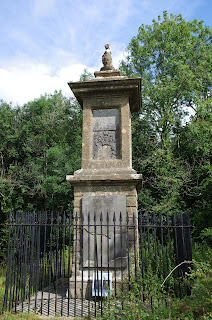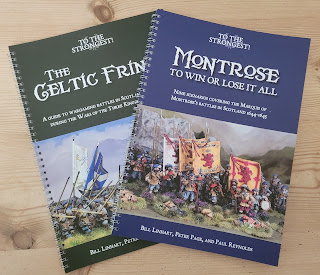Battle of Lansdown, 5th July 1643
Yet another instalment in the adventures of William Waller's Southern Association. This time Waller attempts to defend Bath and stop the King accessing the rich resources of the south west.
Royalists 1 Parliament 0
Next day a Royalist gunpowder cart exploded, temporarily blinding Hopton.
His cavalry had been so good at running away many of his troopers had reached Oxford.
Waller had made it to Bath where he gathered reinforcements.
Loss of gunpowder, no cavalry and a reinvigorated opposition led Hopton to retreat to Devizes.
Royalists 1 Parliament 1
What's There Now?
Sir Bevil Grenville's monument commemorates the death of Sir Bevil (Royalist) on the battlefield -"struck on the head by a poleaxe". Sir Bevil was famous for having a bodyguard, Anthony Payne, who was known as the Cornish Giant (claimed to be 7 foot and 4 inches, 3.3 meters tall). The monument is the oldest war memorial in the UK. There is a circular walk (partly along the Cotswold Way written directions can be found at the Battlefield's Trust Resource Centre) which takes in the plateau which saw much of the fighting. There are a number of artistic markers along the route, and interpretation boards both at the monument and close to the Cotswold Way access point at the parking area.
Update:
I have located the other interpretation boards - one is located at the top of Hanging Hill. Cross the road, next to the parking area, and follow the Cotswold Way along the service road into the Fire Brigade training centre. Continue past the centre, and out onto the pasture. You'll see an OS triangulation pillar and the interpretation board (ST 712 701).
The other board is located next to a stile at ST 724 701 - from Grenville's monument follow the Cotswold Way down the hill and right over a stile, the path skirts around the hill before turning southwards - you'll find the interpretation panels by the next stile.
In Bath centre:
It is worth a detour to visit eighth century Bath Abbey where Waller's army took shelter after the battle. Waller's first wife is buried in the Abbey and she has an impressive memorial with Sir William resplendent in armour en repose.
On the same side of the Abbey (further towards the altar) there is a memorial to Sir Philip Frowde, Colonel of horse and foot for Charles I.
Selected Bibliography
The Battle of Lansdown 1643: An Explorer's Guide J. Wroughton, Lansdown Press
Postcodes for SatNavs
Parking for the Memorial BA1 9DD
Sir Bevil Grenville's monument
Information board at the foot of the monument
The rear of the monument - mind the nettles!
Early on the 5th of July, Waller took up position to the north of Lansdown Hill where his troops began to throw up earthworks. His cavalry attacked small groups of Royalists in the area who fled to join Lord Hopton's main force at Marshfield (5 miles away from Lansdowne). Hopton immediately mustered his army and marched on Waller's position.
Lots of skirmishing ensued, before Hopton's cavalry were routed. Hopton's infantry stood firm and defeated the Parliamentarian cavalry and dragoons; they then stormed Waller's position on Lansdown.
Hopton's cavalry rallied and returned to the fray, where they once again crumpled and fled the battle. Waller withdrew further up Lansdown Hill. Night fell with the armies fixed in position. Under cover of darkness Waller's men left their burning slow matches on the wall: the Royalists could see the glowing matches and believed that Waller's men were maintaining a defensive position behind the wall. In fact Waller's men were leaving their positions and retreating to Bath.
Looking towards Waller's wall
Royalists 1 Parliament 0
Next day a Royalist gunpowder cart exploded, temporarily blinding Hopton.
His cavalry had been so good at running away many of his troopers had reached Oxford.
Waller had made it to Bath where he gathered reinforcements.
Loss of gunpowder, no cavalry and a reinvigorated opposition led Hopton to retreat to Devizes.
Royalists 1 Parliament 1
What's There Now?
Sir Bevil Grenville's monument commemorates the death of Sir Bevil (Royalist) on the battlefield -"struck on the head by a poleaxe". Sir Bevil was famous for having a bodyguard, Anthony Payne, who was known as the Cornish Giant (claimed to be 7 foot and 4 inches, 3.3 meters tall). The monument is the oldest war memorial in the UK. There is a circular walk (partly along the Cotswold Way written directions can be found at the Battlefield's Trust Resource Centre) which takes in the plateau which saw much of the fighting. There are a number of artistic markers along the route, and interpretation boards both at the monument and close to the Cotswold Way access point at the parking area.
Update:
I have located the other interpretation boards - one is located at the top of Hanging Hill. Cross the road, next to the parking area, and follow the Cotswold Way along the service road into the Fire Brigade training centre. Continue past the centre, and out onto the pasture. You'll see an OS triangulation pillar and the interpretation board (ST 712 701).
The other board is located next to a stile at ST 724 701 - from Grenville's monument follow the Cotswold Way down the hill and right over a stile, the path skirts around the hill before turning southwards - you'll find the interpretation panels by the next stile.
Points of interest markers
The interpretation boards close to the parking spot
In Bath centre:
It is worth a detour to visit eighth century Bath Abbey where Waller's army took shelter after the battle. Waller's first wife is buried in the Abbey and she has an impressive memorial with Sir William resplendent in armour en repose.
On the same side of the Abbey (further towards the altar) there is a memorial to Sir Philip Frowde, Colonel of horse and foot for Charles I.
The Fashion Museum in the Assembly Rooms has a small display of seventeenth century dress,
the men's gloves are of particular interest - I pity painters of 28mm figures who really need to put this level of detail on their officers.
Also on display, and easily missed, are a pair of gloves 'associated with Charles I'.
Selected Bibliography
The Battle of Lansdown 1643: An Explorer's Guide J. Wroughton, Lansdown Press
Postcodes for SatNavs
Parking for the Memorial BA1 9DD
If you enjoyed reading this, or any of the other posts, please consider supporting the blog.
Thanks.























Another one of my favourite battlefield walks.. the slope up which the Cornish infantry charged raises the hairs on the back of your neck... and the views to Bristol sets in fine context... been a couple of times now.. must go again!
ReplyDeletehttps://steve-the-wargamer.blogspot.com/2016/06/i-have-been-tolansdown-hill.html
Sadly mine really was a fleeting visit on the way home.
DeleteI struggled to find the location of the information boards - tourist information in Bath couldn't help me, plus they told me to park at the park and ride and walk to the monument. Seems a little daft to go to the trouble of marking out a walk and not telling people what the route is.
Are their six information boards? I only managed two of them.
Gentle readers please visit Steve's link, his post is much better than mine. Local knowledge really helps!
Ha.. not local but the current Mrs Steve the Wargamer and I have visited Bath (mostly at Christmas) for almost 25 years now... I think tat visit was an all too rare summer one while she was meeting up with an old friend... on that visit I too used the park and ride, but only because I'd parked in the city and used the P&R bus.. it's a bit of a trek from their to the battlefield.. maybe the better part of a mile alongside a busy road with no path just the grassy bank.. half way to the monument I cut off to the right (east) of the road and explored the fields behind the "wall" where the Parliamentary forces took up their secondary position.. most of the info boards run along the crest of the ridge east and west from the monument... for a truly beautiful setting for a battlefield it is hard to beat, but I look forward to your visit to Roundway!
DeleteDon't hold your breath for Roundway... it's a bit far from the top left hand corner of Derbyshire!
DeleteHa.. you may have a point.. I have the same problem with Marston Moor... ;o)
DeleteYou've been busy! You've filled out some of the flesh there with your pictures and information from Bath. Thanks for broadening my horizons - I don't think I would have found my way into the Abbey or the Fashion Museum. I find that memorial to Wm Waller's wife very moving. Ah damn it! I've just gone and bought a biography of Waller now.
ReplyDeleteSorry!
DeleteIf you visit the abbey when there is the lunchtime organ recital be prepared to have your fillings rattled.
Great review of the battlefield and museum. 👍🏻
ReplyDeleteThanks
Delete